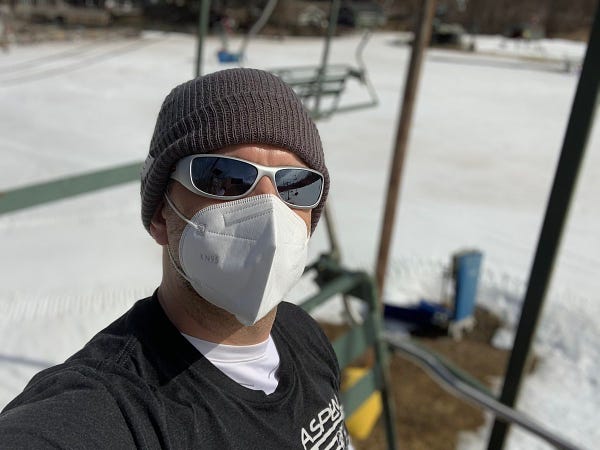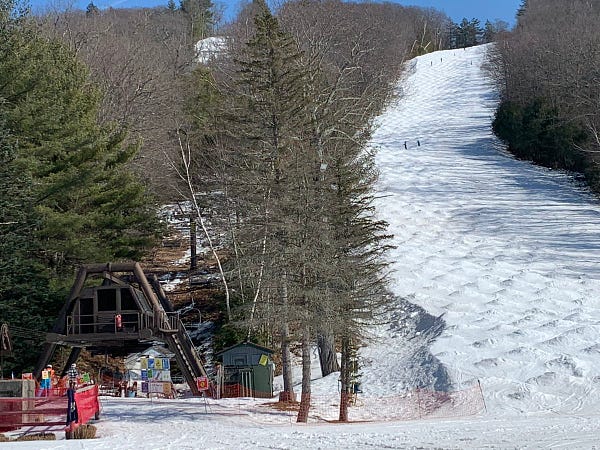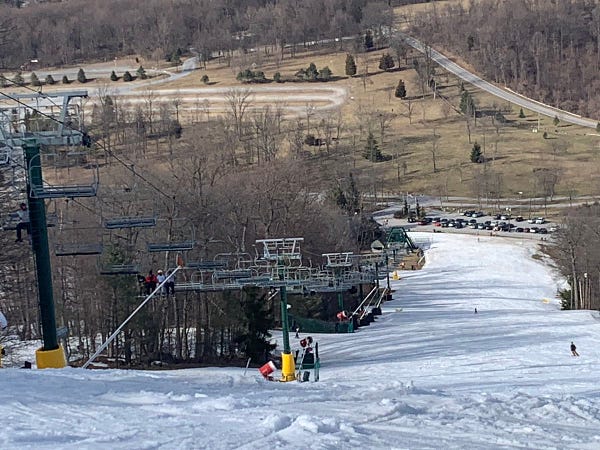Pico Follows Killington with Subscription Pass Option, Teasing Skiing’s Future
Is this how Vail intends to “change everything?”
As tiny Pico steps into the subscription future, can Vail be far behind?
Three years ago, Killington, long the most audaciously performative mountain in the Northeast, did a very Killington thing: it introduced the Beast 365 pass, a sort of super-season pass that included access to everything the mountain offered: skiing at Killington and neighboring Pico, golf, mountain biking, adventure park access, and more.
For Killington, the pass made sense. No ski area in the Northeast is more committed to the long season, which at The Beast can stretch from October to June. Parent company Powdr had made substantial investments in building out the summer business. Killington was truly a year-round resort, and a year-round pass made sense. Skiers could still buy a regular ski season pass, of course, for $939. But the upgrade, at around $1,200, offered a compelling value for anyone even considering the resort’s non-snow activities. And the Beast 365 came with a tantalizing incentive: rather than put up the full amount right away, passholders could opt into $99 monthly payments. It was a subtle but significant shift in how Killington was rethinking its pass model.
“It’s really got a lot of traction,” Killington GM Mike Solimano told me on The Storm Skiing Podcast in 2019, noting that sales had increased 50 percent in the pass’ second season. “It’s more of a subscription-based model like a lot of people are used to, and I think people see a ton of value in it.”
Indeed, we are used to it. The subscription economy, in case you haven’t noticed, has arrived. Once upon a time, consumers would buy a box of Adobe-branded CDs at Best Buy and download them on their computer to acquire Photoshop or Premiere. When a new version of those products came out a few years later, they’d go buy another box of CDs and download the new version. Or not – and that was the problem. In 2013, Adobe switched to a subscription model. Instead of a one-time purchase every so often, Adobe users would now pay a monthly fee. In turn, they would always have the most up-to-date version of the software, which lived not on a CD but in the nebulous cloud. From a business point of view, it couldn’t have worked out better: in the eight years since the pivot, ADBE stock is up around 1,000 percent, compared to about 150 percent return for the S&P 500 as a whole.
That’s one example, but we now subscribe to everything: streaming services, package delivery, groceries, wine. In my home, we subscribe to everything from sponges to toilet paper to socks through Amazon.
So why not skiing? The first and most obvious reason: it’s seasonal. Killington solved that problem by becoming a year-round destination. The ski area has continued to improve the Beast 365, adding an Ikon Base Pass for 2020-21 and 2021-22. The pass is now $120 a month. Skiers who want the ski-only pass can still get it for $1,029, but monthly payments are not an option – just a three-part payment plan, with nearly $400 due up front. Powdr has rolled out a similar product out West at Mount Bachelor, which offers the same kind of varied year-round experience.
How to make the model work with a smaller operation was not so obvious, but last week, Killington quietly rolled out a year-round subscription product to Pico, its little-neighbor-next-door whose ski season typically runs just four months, give or take a few weeks. The awkwardly named Pico KA All Seasons Pass is $900 a year, or $75 per month. This is substantially more than the ski area’s $449 season pass, but it tacks on four ski days at Killington plus all the Beast 365 add-ons (minus the Ikon Pass): unlimited biking, golf, adventure park, and scenic gondola rides, plus a bunch of other perks.
But this is not just a one-year subscription. As both mountains’ websites clearly state, “The monthly fee will continue indefinitely, purchasers will not need to sign up again next year.” Killington wants to convert you from a customer for the season to a customer for life. For the passholder, it’s a nice deal: no more scrambling to come up with $1,000 every spring. For frequent skiers with active offseason calendars, the perks are enormous. For the resort, it’s even better: recurring revenue spread across the calendar. This introduces enormous stability into an industry historically tethered to weather and a few holiday periods.
Powdr is an outlier for now. I don’t think it will be for much longer. Last week, Vail dropped this cryptic tweet:
On its earnings call the next day, CEO Rob Katz hinted at the company’s direction in its earnings call with investors (emphasis mine):
“We obviously went into this season, which had more uncertainty than any time any of us could remember, and I think our pass program was at the cornerstone of the results that we delivered. And sure, of course our lift ticket sales are also critical, but obviously that’s the most uncertain, and the hardest to predict, and in many respects, the larger that we grow that pass program, the greater opportunity that we have to grow a business that 10, 15 years ago was truly a day-of decision based on snow and we’ve really moved it much more toward kind of a subscription approach to how people are engaging or buying their skiing for a season, whether it’s for an unlimited product or even if it’s just for an Epic three-day, right? Either way, we’ve really started to make inroads, so what I would say is we feel like there’s a unique opportunity to continue to be aggressive on that front and really move big numbers of people into the program.”
The Epic Pass removed a lot of the uncertainty from Vail Resorts’ business model. By front-loading pass revenue, it somewhat detached the company from liabilities of a low-snow year. But it is still an opt-in model – skiers have to choose to repurchase it every year, and the revenue is concentrated in the April-to-December sales period. There is an auto-renewal option, (which I can tell you from personal experience is a pain-in-the-ass to opt out of), but it is still an option. A subscription, presumably, would go on until a passholder cancelled it. Vail has invested substantially in its summer businesses, but it still usually loses money in its fiscal fourth quarter. A move to year-round subscriptions would help mitigate that, and whether it happens next week or not, I think it’s inevitable. The only question is how long it will take everyone else to follow.
Most of us would probably give up when we couldn’t find the gas cap on the chairlift
There’s an episode of How I Met Your Mother where main character Ted, according to his older-self narrator, “uttered five little words that every man at some point in his life will say: We should buy a bar!’”
The ever-scheming Barney enthusiastically agrees. Hijinx ensue. Another great story in the vault.
Yes, we should buy a bar. Of course all drunken young men say this, and of course they all envision in that moment the greatest bar ever, a multi-storied palace with dollar pitchers and singalongs hanging out the flung-open windows at 3 a.m. Packed and wild, sports on every TV, music so loud it renders language extinct. But this is not what happens because this is not how reality works. Owning a bar is expensive and hard and a world-class pain-in-the-ass. Sober people understand this.
Skiers do this too. At some point we all think we would buy and rescue a ski area and it would be the greatest ski area in the world. Lifts everywhere and zero grooming and tree-skiing all over and cliffs and nothing roped off ever and at the base only a bar and a hot tub because who gives a shit about anything else? Ski school is for Jerrys and rentals are for Jerrys and what’s with all these Jerrys wanting to Jerry up our ski area, huh?
Jon Schaefer runs a ski area that way, though with a version more anchored in a reality in which families and beginners exist. In a typically energetic note posted last week to his mountains’ websites, the Northeast’s most fearless ski area operator announced two new lifts for Catamount and one for Berkshire East. Both would likely come with immediate terrain expansions. Massive snowmaking upgrades are coming. They’re exploring “battery backup systems” to “disconnect our demand charges from the grid.” He admitted their terrible e-commerce system was terrible and would be replaced this offseason. Oh, and they’re still making snow. These announcements continue years of furious and continuous development at both ski areas.
Why don’t more people run ski areas like this? Why don’t more people do all the things skiers want them to do and do it fast and do it in furious tornadic fashion that’s blinding and bewildering to behold? Why don’t more people turn boring ski areas into tenaciously interesting ones, glading and burning new trails and tossing lifts up through the trees and burying the place in snow from the first frost to the last? Why don’t more people run ski areas like we all know we would run a ski area?
The answer is simple: most people don’t run a ski area like Jon Schaefer because most people can’t run a ski area like Jon Schaefer. Like some kind of apprentice of the howling North, he literally grew up on the slopes of Berkshire East, every spare minute of wintertime childhood spent absorbing the arts of ski area operation. When his father Roy arrived from Michigan in the 1970s, toting three kids in a station wagon, he found a beaten-down and ramshackle operation and kept it alive through a fantastic devotion to the frugal and the inventive, the whole outfit a Frankenslope stitched together from two dozen broken and lost ski areas across the country. Like a clan of samurais practicing and perfecting their arts in the high-mountain caves over centuries, the Schaefers have honed the improbable craft of making skiing function at a high level in, of all places, Massachusetts. Like a man raised among wolves, Jon is wired for a different world. He is not like the rest of us. He is a mountain wizard in an artform us terrestrial people can study but never truly master.
Reading recommendations corner
You’re reading this newsletter on Substack. When I launched The Storm on this platform in October 2019, it was the only ski-related publication there. A bunch more have launched recently. Check them out:
The Ski Phoenix: Launched by Greg Fitzsimmons in February, this newsletter “is one writer’s attempt at sparking dialogue and igniting excitement in the ski world through storytelling.” It’s wide-ranging: the last two issues focused, respectively, on some novel ideas for Epic and Ikon passes and a liftline conversation with a pair of seventy-something Aspen locals.
Have RV Will Ski: Scott Colesworthy lives in Minnesota. He loves to ski. He loves to travel. He wants to try this whole RV-in-the-winter thing out. He describes himself as among the “early retired go-go types who crave adventure and are physically fit and active.” Armed with some multipasses, a willingness to fail, a good nature, and a lot of time, he’s aimed his RV toward the Rockies on a series of powder quests this winter. He’s had good days and bad ones, and I’ve appreciated his candor in scrubbing some reality into the ecstatic van-life fantasy as distilled through social media.
The Butternut Special: Published by the mysterious Butternut, identified only as a person who loves, “making turns in fresh snow, but will accept mediocre and even garbage snow as long as I’m with the right people (and dogs) and are enjoying ourselves,” this newsletter delivers concise, experimental, and slightly melancholy posts. Some are backcountry adventures. Some are… not. It’s an interesting read, whatever it turns out to be.
The Well Fed Skier: I’m not super into food journalism, but Rick Anglin is an entertaining writer. Inspired by overstuffed Mammoth bus trips in his 20s, in which the menu for 60 would inevitably feature, “the ubiquitous spaghetti in all its various incarnations,” this newsletter aims to “take you on a journey into savory mountain cuisine…” Anglin does a nice job of weaving the food into ski adventures, like this recollection of a potent cocktail known as the Fudpucker and a jaunt from Snowbird to the old Park West to Jackson Hole to Sun Valley, or the latest post, which skips across the Rockies and Europe exploring the nuances of on-slope dining.
Elsewhere
New York Ski Blog at Mount Peter, Hunter, and Windham. SAM’s season pass round-up includes a nice shout-out to The Storm. Vail Resorts will pay end-of-season bonuses of up to $1,500 to 28,000 employees after announcing better-than-expected second-quarter earnings. A Sunapee auction from March 19 to 20 that includes old Duckling double chairs will benefit the EpicPromise Foundation. The U.S.’ second indoor ski slope could be in Northern Virginia. Consider the cross-country ski.
Low Pressure Podcast nails this interview with trailmap-making legend James Niehues. I really dig this Last Chair Series segment with New England Lost Ski Areas project founder (and friend of The Storm) Jeremy Davis (still one of my favorite podcasts). Alba Adventures latest, at Royal Mountain, New York:
I was there a few weeks ago. It was fantastic.
Also these New England Ski Journal TV episodes are really terrific. I’ve been forgetting to embed them this year, but here’s an episode examining how business is going this season at Ski Bradford, Loon, Gunstock, and Sugarbush:
This week in skiing
Wednesday, March 10 – Ski Sundown
Hoodie-clad and with the windows down I pulled into this Connecticut bump in the late afternoon. What I saw surprised me:
It not only resembles a real ski area, it is one. Those bumps are real bumps and the pitch is nice and the trail network winds through the woods off that summit triple in meandering and interesting ways. It was sunny and 60 degrees and uncrowded and here was the glorious spring skiing I’d waited two years for after last year’s Covid train-robbery. I bought a two-hour ticket because they offer that here because of course they do. It was plenty of time to explore the main trailpod plus the mini-pod looker’s right where a little triple and a pair of carpets serve a delightful beginner’s area, which unlike most beginner’s areas is not just a broad plain hacked out of the forest but an actual trail network. This is the best ski area in Connecticut.
Friday, March 12 – Bear Creek, Spring Mountain, Roundtop
More spring skiing on Friday and this was one of the great spring skiing days of my life, 70 degrees, T-shirt skiing, the sun high and steady and all three ski areas I hit close to 100 percent open.


At Bear Creek I lapped empty quad lifts and waited until the morning sun had softened the blacks dropping off F lift and then bombed Sasquatch on repeat, the corn silky, fantastic for the half dozen turns it took to descend. Nice bumps off Grizzly. It took an hour to ski the mountain but I stayed for two to devour the perfect snow.
Spring Mountain is one of these places that feels forgotten even by the people running it, its lifts rusted and worn, its trails and base areas dotted with boarded-up shacks and odd assortments of props from what look to be Halloween experiences. It is just 35 miles north of Philadelphia and no one was there. Nonetheless I enjoyed the place, its split peaks separated by long narrow trails making it feel far larger than it is, little jumps all over, the trails baked marvelously beneath the springtime sky. The summit lift looker’s left was for some reason closed and so I hiked up and skied corn-corduroy which ought to be its own special class of hollering freefall. The only run closed was the double-diamond Plummet and it was melted down to grass so not poachable. I hope this place survives because this.
Two hours west sat Roundtop, thrusting out of the countryside like something built or bulldozed into being. It too was empty but the snow everywhere was magnificent, fast and soft and pre-slushy. Big bumps everywhere. What snowmakers do in Pennsylvania is just an indescribable thing and if these people were put in charge of I don’t know Wolf Creek the place would probably never close, so improbable is the work they do manufacturing deep snowbases in a snow-barren landscape.
Sunday, March 14 – Mountain Creek
This is a weird thing to say but I only tend to ski Mountain Creek when conditions are terrible. I have a season pass because it’s dirt-cheap and the ski area is close and it’s a big mountain but when conditions are prime the liftlines are breadlines-at-wartime insane. But the big snows of February have all melted and even though the base is still deep and the whole mountain’s still open the crowds have thinned from their yay-it’s-winter peaks. So from 8 a.m. until 11 I sailed onto the lift mostly alone and just lapped South Peak and then Granite for a run or two. Then the rest of New Jersey showed up and I left like I always do when they arrive but I stacked up like 14,000 feet of vertical in less than three hours and I was pretty satisfied with that for a day’s work and I was home by lunchtime.







Just got back from Killington, a place I have been skiing for over thirty years, from a midweek weekend Tuesday and Wednesday trip. Caught the peak of a Spring cycle that started out in the single digits on Monday and progressed to about 50 on Wednesday afternoon. I was super impressed by the conditions and amount of grooming and just general excellent operations management. They really have their act together, after some stumbling and bumbling by Powdr over the last five to seven years. That is what keeps on bringing me back to that mountain, not subscription schemes or silly party themes. I can depend on an excellent skiing experience over a wide part of that mountain in the midweek after driving four hours plus, something I can't say about many other mountains in the east. (I was actually told by a CSR at Gore one time that most of the chairs weren't running because it was Tuesday. Really. You want me back, with that attitude?)
Btw, get it while you can there, because the warm forecast starting Saturday is going to melt a lot of it away. Unfortunately, a very non snowy March in 2021.
So yea we're all ADD and don't read 3000 words of anything. Except SSJ. Great read and insight. Will not be surprised if all the epik predictions laid out here come true.